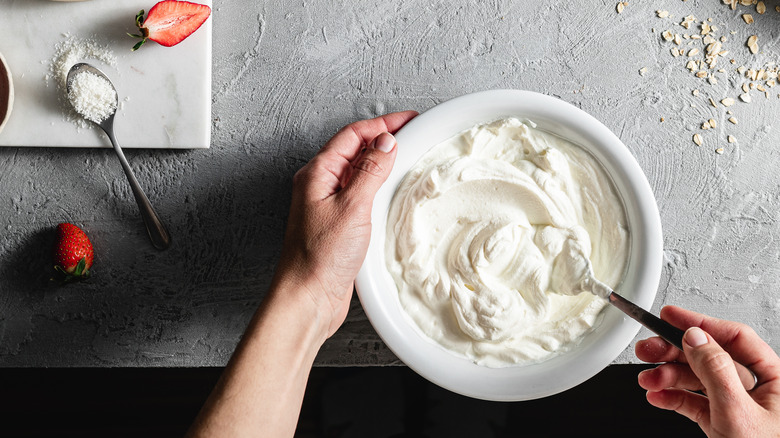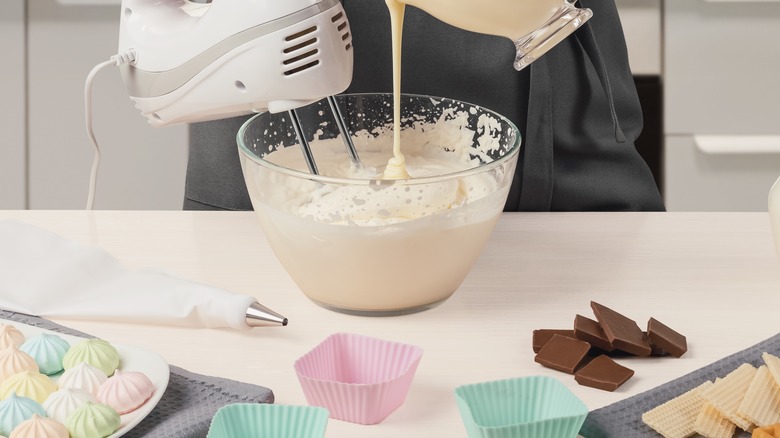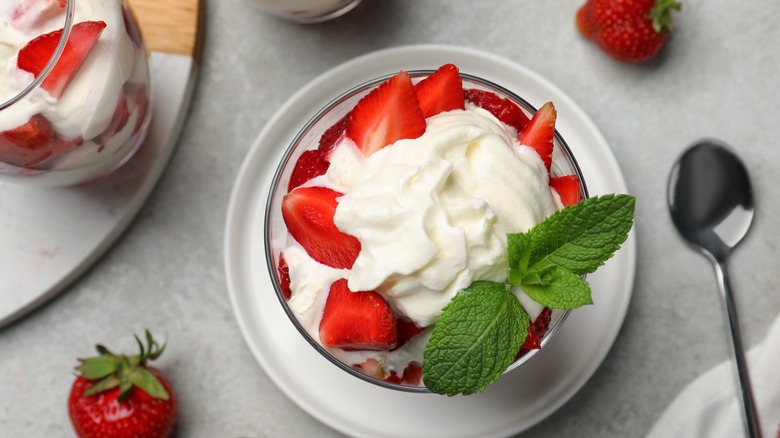How Do You Make Stabilized Whipped Cream?
While homemade whipped cream tastes undeniably fresh, the silky confection is also known to lose its fluffy, airy texture when it's left out too long or stored in the fridge for an extended period of time. This is because the aerated, whipped structure eventually loses its stability by deflating or "weeping" out its water content. Luckily, you can make a more stabilized version by simply adding in a starchy bulking agent or an acidic ingredient to fortify the cream's fat matrix so it retains its beloved lightness.
Starchy ingredients like corn starch, powdered sugar, or instant pudding help the whipped cream hold onto the water molecules within, preventing the fat and water from separating. Similarly, adding in a tangy, acidic ingredient like a dollop of Greek yogurt or mascarpone cheese provides extra stability and strength, which will also keep the fat structure from breaking for a couple days. Cream of tartar works in a similar way.
Alternatively, some recommend adding in a protein-rich ingredient like gelatin to help provide bulk to the whipped cream so it holds its shape longer. While you can technically use any of these stabilizing ingredients you have on hand, it does help to consider the baking application, desired texture, and how long you need your whipped cream to hold up when choosing one.
Each stabilizer will provide a slightly different impact
To bulk up your homemade whipped cream so it's hearty enough to pipe stars atop a pie — without worrying about them melting for a couple hours — a bit of starch will do the trick. Simply add in a tablespoon of cornstarch, powdered sugar, or instant pudding mix along with the heavy cream prior to whipping up soft peaks.
If you need a thicker, sturdier whipped cream that stays airy and can be used to layer between cakes like frosting, add in gelatin. Commonly found in marshmallows and other fluffy confections, it's said to provide the most structural support and strength to the whipped cream. To incorporate gelatin, first add water to the mix and heat it up, then cool it down before whipping it with cream. Plant-based gelatin alternatives, like instant gels are also widely available.
For a more luxurious whipped cream you can store in the fridge for dolloping on ice cream, add in some Greek yogurt or mascarpone cheese. The extra fat and acidity from these dairy ingredients will help hold the shape and provide an extra rich mouthfeel and taste. To incorporate, simply beat in a heaping spoonful of either dairy product right after your whipped cream starts to form soft peaks. Note: these ingredients will add some slight tartness to the mix, which may very well be a good thing when layering whipped cream between cubes of angel food cake and sliced fresh strawberries, for example.
Additional tips for making the best whipped cream
Once you try your hand at making stabilized whipped cream, you'll see there's no need for the stuff you can buy in a tub or a can at the grocery store. Homemade and fresh is always better quality, especially when you know the tricks to keep it all nice and fluffy. To ensure your cream comes together smoothly, and to reduce its risk of deflating, the temperature of your ingredients and kitchen tools are also key. Prior to whipping things up, make sure to keep your cream, mixing bowl, and mixing paddle cold by storing them in the fridge. This goes for any additional Greek yogurt or mascarpone, too, if you're going to be mixing them in.
Also, be careful not to over-whip the mixture, as this can turn your cream into chunky butter bits. Simply whip the cream, sugar, and any stabilizing ingredients together until they begin to form a pillowy texture that holds its shape in the form of soft peaks. Once ready, make sure to store the fluffy confection in the fridge for food safety, extended shelf-life, and extra structural stability.



